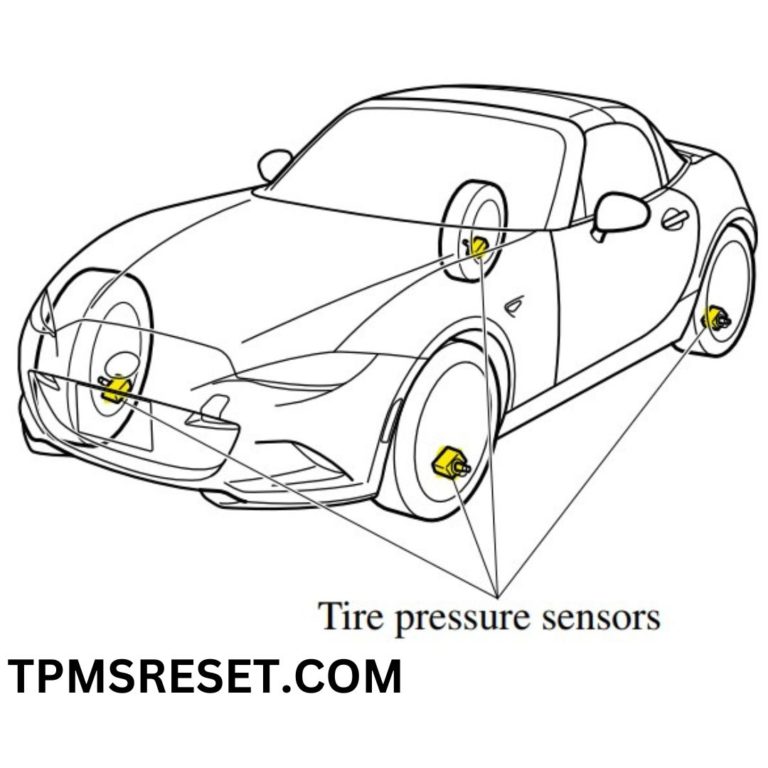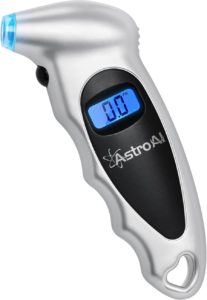Steps to Reset 2018-2024 Mazda MX-5 TPMS
Step 1: Check and Adjust the Tire Pressure
All Mazda MX-5 models since 2019 do not have a tire pressure reset button like the previous models. So, it’s even more important for you to know how to reset your tire light! First things first, you need to set your tire pressure to the correct levels. On the driver’s side door jamb there’s a yellow and white sticker. Set all 4 tires to the exact pressure levels on the sticker. Remember to adjust the tire pressure only when the tires are cold. (this means before driving long distances or after your car has been parked for a few hours) Check out the chart below and match your MX-5 model tires to its recommended pressure.
Trim Model | Tire Size | Inflation PSI Front/Rear |
2023 Mazda MX-5 | 195/50R16 | 29 PSI/29 PSI |
2023 Mazda MX-5 | 205/45R17 | 29 PSI/29 PSI |
Step 2: Drive the Car
Once you’ve set the tire pressures to the recommended cold levels, proceed to drive your vehicle. According to Mazda, it is necessary to drive for a minimum of 3 minutes at speeds exceeding 16 mph. Following this, the tire pressure light should deactivate. From personal experience, it may take up to 15 minutes of driving for the light to turn off.
Step 3: Re-Check the Tire Pressure
If your tire pressure light doesn’t go off after steps 1 and 2, recheck your tire pressure. Confirm that the pressure is still at the exact pressure you set it to. If it’s not, you likely have some kind of tire leak or puncture. If the tire light goes off and then comes back on, you definitely have a tire leak. Read below to learn what a flashing TPMS light means.
These steps work for all MX-5 models and trims including Miata convertible and Miata RF.
Steps to Reset 2012-2017 Mazda MX-5 TPMS
If your Mazda MX-5 Does not have the tire reset button on the left of the steering wheel, follow the procedure above.
Adjust all 4 tires to the recommended levels found below or on the door jamb sticker.
Turn the ignition switch to the “ON” position or with the car running.
Press and hold the tire pressure monitoring system (TPMS) button until the TPMS indicator light on the instrument cluster flashes twice. (it will also say “Tire Pressure Monitor Initialized”)
Release the TPMS button. The TPMS indicator light will turn off.
Drive the vehicle at speeds above 16 mph (25 km/h) for at least 10 minutes.
TIP: If the tire pressure light won’t go off after following these steps, double check your air pressure manually with a tire pressure gauge and then repeat the reset procedure. Sometimes it takes following this process more than once. (Digital tire pressure gauge we recommend at the bottom of this page)
Trim Model | Tire Size | Inflation PSI Front/Rear |
2013-2017 MX-5 | 205/45R17 | 29 PSI/29 PSI |
2013-2017 MX-5 | 205/50r16 | 29 PSI/29 PSI |
Mazda MX-5 TPMS Malfunction Indicator
Your Mazda MX-5 is equipped with a TPMS malfunction indicator, which notifies you if the system is not operating as intended. This indicator functions in tandem with the low tire pressure warning light. When the tire monitoring system encounters an issue, the warning light will flash for approximately one minute before remaining steadily illuminated. This sequence will recur each time the vehicle starts until the problem is addressed. When the malfunction indicator is active, the system may be unable to detect or signal low tire pressure as intended. In basic terms, the tire pressure monitoring system will not function properly until the TPMS issue is resolved. Put simply, a blinking tire pressure light indicates a problem with the TPMS system itself rather than an air pressure issue. Thus, if you have a faulty tire pressure sensor, your TPMS will malfunction.
Always Reset Tire Pressure Monitoring System in these Cases:
After tire pressure has been adjusted.
After a pressure sensor has been replaced.
After tire rotation has been performed.
After tire balances or wheel alignments.
After any tire or wheel has been replaced. Or removed and put back on.
After when the vehicle battery dies, has been drained, or jumped.
After the TPMS light turns on.
If your vehicle load weight increases dramatically or you’re towing something.
After a long period of inactivity, if the car sits for long periods of time.
How Mazda MX-5 TPMS Works
The Mazda MX-5 tire pressure monitoring system (TPMS) utilizes individual pressure sensors located inside each tire.
These pressure sensors are battery-powered and measure tire pressure and temperature continuously, even when the car is not in motion.
The tire pressure data collected by the sensors is transmitted wirelessly to the vehicle’s onboard computer or TPMS control module, which processes and analyzes the information.
If the tire pressure in any tire drops below a predetermined threshold (usually around 15% to 25% below the recommended pressure), the low tire pressure warning light is activated on the dashboard to alert the driver. (as well as an audible beep)
After addressing the tire with low tire pressure or fixing the TPMS malfunction (replacing a sensor or tire valve), you should reset the system.
The TPMS will continue to monitor tire pressure and temperature, providing real-time data to the onboard computer.
What Causes the TPMS light to Turn On?
Naturally occurring pressure loss: Tires can lose pressure over time due to permeation and tread rot.
Temperature fluctuations: Tire pressure can be affected by significant changes in temperature, usually decreasing in colder weather and increasing in warmer conditions. Scroll down to learn more about this.
Tire puncture or damage: A sharp object like a nail or screw, can cause a puncture, leading to a rapid loss of tire pressure.
Valve stem leakage: The valve stem, which is used to inflate the tire, can develop leaks over time. This will cause a SLOW leak. There are kits so that the valve can be replaced without having to replace the entire sensor. Get some soapy water and check for bubbles.
Wheel damage: Impact from potholes, curbs, or other road hazards can cause damage to the wheel, leading to air pressure loss in the tire.
TPMS sensor failure: A malfunctioning or damaged tire pressure sensor can cause false readings or trigger the tire pressure warning light.
TPMS sensor battery depletion: The battery inside the tire pressure sensor has a limited lifespan and can eventually deplete, causing the sensor to malfunction.
Heavy cargo: Loading your vehicle with excessive weight can impact tire pressure, potentially triggering the tire pressure warning light. This includes towing.
Seasonal tire changes: Switching between summer and winter tires can lead to pressure changes, especially if the tires have been stored for an extended period. TIP: Remember to swap sensors from one set of tires to the others if you are using two sets of wheels.
Tire or wheel replacement: If a new tire or wheel is installed without properly calibrating the TPMS, the system may not function correctly.
TPMS system malfunction: Issues with the TPMS system itself, such as communication problems between the sensors and the onboard computer or TPMS receiver, can cause the warning light to activate. (it will cause a flashing TPMS light, a malfunction)
After tire rotation: If the tires have been rotated without resetting the TPMS, the system may provide inaccurate readings or trigger the warning light. The MX-5 Miata computer might think the front tires are in the rear and the rear in the front.
Altitude changes: Significant changes in altitude can affect tire pressure due to changes in atmospheric pressure.
Tire Pressure and Air Temperature
In the colder months, when the surrounding temperature tends to drop, leading to a decrease in tire temperatures. This drop in temperature also results in reduced air pressure in your tires. So as a result, the TPMS warning light will turn on more frequently during these seasons. The chart demonstrates the correlation between changes in air temperature and tire pressure, displaying the information in both Fahrenheit and Celsius, as well as PSI and kPa units. It’s important to note that the standard temperature for checking tire pressure is approximately 62°F (16.7°C), at which point tire pressure typically remains stable. In essence, for every 10-degree Fahrenheit decrease in air temperature, tire pressure is going to drop by about 1 PSI.
Benefits of Tire Pressure Monitoring in Mazda MX-5
Improved safety: The tyre pressure monitoring system alerts you when your tyre pressure is low, helping to prevent accidents caused by underinflated tires, which can lead to poor handling, longer stopping distances, and even blowouts.
Enhanced fuel efficiency: Properly inflated tires help maintain optimal fuel economy, reducing fuel consumption and saving you money at the pump. Every penny counts!
Prolonged tire life: By keeping tires at the correct pressure levels, you will prevent uneven tire tread wear and extend the lifespan of your tires, resulting in cost savings. More money!
Better ride comfort: Maintaining the right tire pressure ensures a smoother, more comfortable driving experience.
Reduced carbon footprint: Optimal tire pressure contributes to better fuel efficiency, which in turn reduces CO2 emissions and helps protect the environment.
Real-time monitoring: The TPMS is constantly measuring your tire pressure, allowing you to address potential issues before they become major problems. This is why you should stop and check your tire pressure as soon as your tire light turns on!
Convenience: The warning light on your dashboard provides a clear and easily recognizable signal when tire pressure needs attention.
Easy troubleshooting: In the event of a TPM malfunction, the system’s indicator light will flash, signaling the need for maintenance or repairs.
Peace of mind: This is probably the best thing about having a TPMS. Knowing that your Mazda MX-5’s TPMS is continuously monitoring tire pressure allows you to focus on enjoying the driving experience with confidence.
Conclusion
Resetting the tire pressure warning light on a 2023 Mazda MX-5 is a simple task that only takes a few steps to complete. By carefully following the instructions outlined in this article, you can ensure that your tire pressure monitoring system functions accurately, allowing your Mazda Miata to perform at its peak.
Please note that this blog post contains Amazon affiliate links. This means that if you make a purchase through one of these links, the author of the blog may earn a small commission at no extra cost to you. The author only recommends products that they personally use and believe in. Thank you for supporting this blog.





